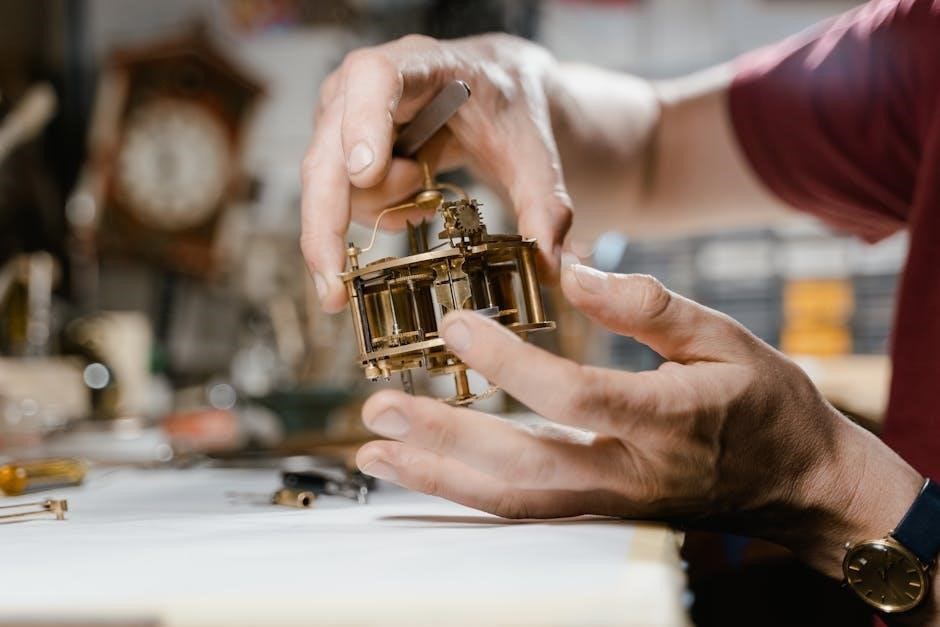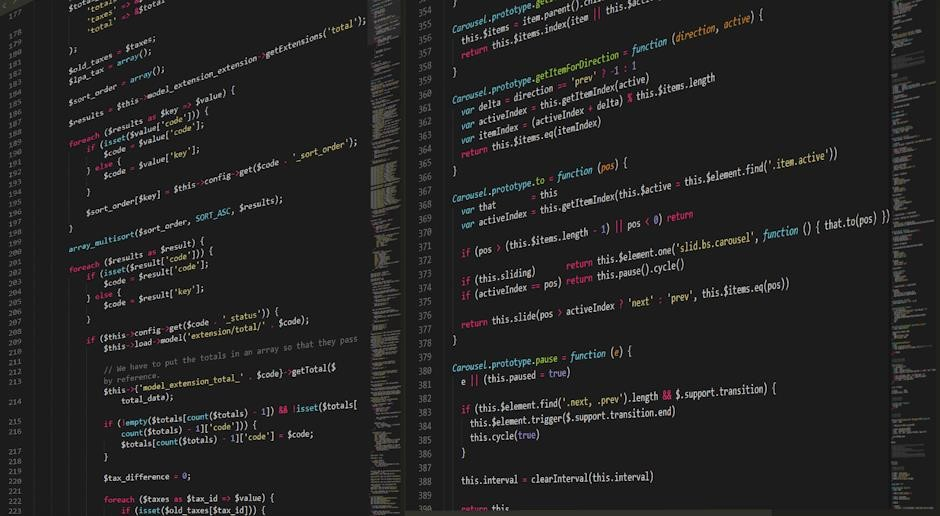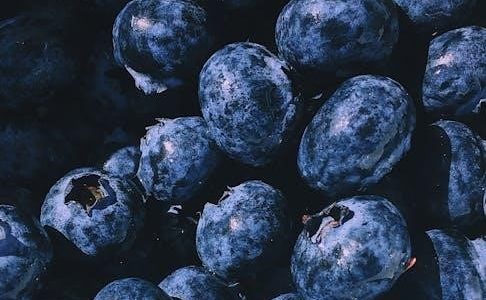Overview of the Human Digestive System
The human digestive system comprises the GI tract and accessory organs, functioning to break down food, absorb nutrients, and expel waste, enabling energy production and growth through efficient digestion.
1.1 Key Components of the Digestive System
The key components include the mouth, esophagus, stomach, small intestine, and large intestine, along with accessory organs like the pancreas, liver, and gallbladder. Each part plays a specific role in breaking down food, absorbing nutrients, and eliminating waste. Together, they form a complex system essential for overall health and proper bodily functions.
The digestive process involves the breakdown of food into nutrients through mechanical and chemical processes. It begins with ingestion, progresses through the GI tract, and involves organs like the mouth, esophagus, stomach, and intestines. Accessory organs such as the pancreas, liver, and gallbladder contribute enzymes and bile. This coordinated effort enables nutrient absorption, energy production, and waste elimination, maintaining overall health and bodily functions.

The Mouth and Its Role in Digestion
The mouth initiates digestion through mechanical breakdown by teeth and tongue, mixing food with saliva containing enzymes like amylase, beginning the chemical digestion process.
2.1 Structure and Function of the Mouth
The mouth, the first digestive organ, contains teeth for mechanical breakdown, a tongue for mixing, and salivary glands producing enzymes like amylase to initiate chemical digestion, transforming food into a manageable bolus for swallowing.
2.2 Role of Teeth, Tongue, and Salivary Glands
Teeth mechanically break down food into smaller pieces, enhancing surface area for enzymes. The tongue mixes food with saliva and aids swallowing. Salivary glands produce saliva containing amylase, which begins carbohydrate digestion, and lysozyme, which has antimicrobial properties, ensuring efficient chemical digestion and preparation for the next digestive stages.
The Esophagus and Swallowing Mechanism
The esophagus is a muscular tube transporting food from the mouth to the stomach via peristalsis, ensuring safe passage through the lower esophageal sphincter to the stomach.
3.1 Structure of the Esophagus
The esophagus is a muscular, hollow tube lined with mucus membranes, stretching from the throat to the stomach. Its walls contain layers of muscle and connective tissue, enabling peristalsis to propel food safely to the stomach through the lower esophageal sphincter, preventing backflow and ensuring efficient digestion and nutrient absorption in the digestive process.
3.2 The Process of Swallowing and Peristalsis
Swallowing begins voluntarily in the mouth, with the tongue pushing food into the throat. The epiglottis folds over the windpipe, preventing food from entering the lungs. Peristalsis, rhythmic muscle contractions, propels food through the esophagus into the stomach. The lower esophageal sphincter relaxes to allow passage, then tightens to prevent reflux, ensuring efficient movement and digestion through involuntary muscle coordination guided by the brain.
The Stomach and Its Functions
The stomach is a muscular sac that mechanically mixes food with digestive juices, breaking it down into chyme. Its acidic environment and enzymes initiate protein digestion, preparing food for further processing in the intestines through churning and enzymatic action.
4.1 Gastric Structure and Muscular Movements
The stomach is a muscular sac with layered muscles, including circular and longitudinal layers, enabling rhythmic churning to mix food with digestive juices. Muscular movements create a grinding action, breaking food into a semi-liquid chyme. The lower esophageal sphincter prevents reflux, while the pyloric sphincter regulates chyme release into the small intestine, ensuring efficient digestion and nutrient absorption through controlled movements and contractions.
4.2 Digestive Juices and the Formation of Chyme
The stomach secretes digestive juices containing enzymes like pepsin and gastric amylase, which break down proteins and carbohydrates. These juices, mixed with food through muscular contractions, form a semi-liquid mixture called chyme. The process involves the lower esophageal sphincter allowing food entry and the pyloric sphincter controlling chyme release into the small intestine for further digestion and nutrient absorption.
The Small Intestine and Nutrient Absorption
The small intestine is a long, thin tube where most nutrient absorption occurs. Its lining has specialized structures that enhance the absorption of nutrients into the bloodstream.
5.1 Parts of the Small Intestine: Duodenum, Jejunum, and Ileum
The small intestine is divided into three distinct sections: the duodenum, jejunum, and ileum. The duodenum receives bile and pancreatic juices to further break down food. The jejunum absorbs carbohydrates and proteins, while the ileum absorbs vitamin B12 and remaining nutrients, ensuring efficient nutrient uptake before waste moves to the large intestine.
5.2 Role of Pancreatic Juice, Bile, and Intestinal Juices
Pancreatic juice contains enzymes that break down carbohydrates, fats, and proteins. Bile from the liver emulsifies fats, enhancing digestion. Intestinal juices further digest nutrients, while bacteria in the small intestine produce enzymes for carbohydrate breakdown. Together, these fluids ensure complete nutrient absorption, maintaining the body’s energy and health through efficient biochemical processes in the small intestine.

The Pancreas and Its Digestive Enzymes
The pancreas produces digestive enzymes like amylase, lipase, and trypsin, which break down carbohydrates, fats, and proteins, aiding in nutrient absorption and maintaining digestive health effectively.
6.1 Structure and Function of the Pancreas
The pancreas is a glandular organ located behind the stomach, consisting of exocrine and endocrine cells. Exocrine cells produce digestive enzymes, while endocrine cells, like islets of Langerhans, produce hormones such as insulin and glucagon. These enzymes and hormones are vital for digestion and glucose regulation, ensuring proper nutrient absorption and metabolic balance through precise cellular functions and secretions.
6.2 Types of Digestive Enzymes Produced by the Pancreas
The pancreas produces enzymes like amylase, lipase, and trypsin, which break down carbohydrates, fats, and proteins, respectively. These enzymes are released into the small intestine to further digest food into simple sugars, fatty acids, and amino acids, facilitating nutrient absorption and utilization by the body for energy and metabolic processes through enzymatic hydrolysis.
The Liver and Gallbladder: Bile Production and Storage
The liver produces bile to emulsify fats, aiding digestion, while the gallbladder stores and releases bile into the small intestine for fat absorption.
7.1 Liver Function in Digestion
The liver plays a crucial role in digestion by producing bile, which aids in fat emulsification and vitamin absorption. It also detoxifies harmful substances, regulates metabolism, and stores glycogen, supporting energy production. The liver’s bile is stored in the gallbladder and released into the small intestine to facilitate digestion.
7.2 Role of the Gallbladder in Bile Storage and Release
The gallbladder stores bile from the liver, concentrating it for efficient fat digestion. During meals, it releases bile into the small intestine via bile ducts, aiding in fat emulsification and nutrient absorption. This process is regulated by hormones, ensuring bile release aligns with food intake, optimizing digestion and nutrient utilization effectively.
The Large Intestine and Water Absorption
The large intestine, comprising the colon, rectum, and anus, absorbs water from undigested food, solidifying waste and preparing it for excretion, while maintaining proper electrolyte balance.
8.1 Structure of the Large Intestine: Colon, Rectum, and Anus
The large intestine consists of the colon, rectum, and anus. The colon, a muscular tube, absorbs water and electrolytes, while the rectum stores stool temporarily. The anus, with its sphincter muscles, controls stool expulsion, completing the digestive process efficiently. These structures collectively ensure proper water absorption and waste management, maintaining overall digestive health and regular bowel movements.
8.2 Functions of the Large Intestine in Water Absorption and Waste Formation
The large intestine absorbs water and electrolytes, transforming liquid waste into solid stool. The colon facilitates water absorption, while the rectum stores stool until elimination. The anus, equipped with sphincter muscles, regulates bowel movements. This process ensures proper hydration, waste compaction, and elimination, maintaining digestive health and preventing dehydration by efficiently managing the body’s water balance and waste removal.

Accessory Organs of the Digestive System
The accessory organs—pancreas, liver, gallbladder, and salivary glands—produce enzymes and bile, aiding digestion and nutrient absorption through secretions and storage, essential for proper digestion.
9.1 Salivary Glands and Their Role
Salivary glands produce saliva, which contains enzymes like amylase to break down carbohydrates. Saliva moistens food, easing swallowing and initiating digestion in the mouth. It also lubricates food for smooth passage into the esophagus, preventing choking. While the digestive process begins here, detailed enzymatic breakdown occurs later in the digestive tract, as outlined in other sections of this guide.
9;2 The Role of the Liver, Pancreas, and Gallbladder
The liver produces bile, aiding fat digestion, while the pancreas secretes enzymes to break down proteins, carbs, and fats. The gallbladder stores bile, releasing it into the small intestine to enhance nutrient absorption. Together, these organs ensure effective digestion, with the liver also detoxifying and the pancreas supporting metabolism, while the gallbladder optimizes bile availability for fat digestion efficiency.
The Digestive Process: From Ingestion to Excretion
The digestive process begins with ingestion, where food is chewed and mixed with saliva in the mouth. It then travels through the esophagus into the stomach, where acids and enzymes break it down. The mixture enters the small intestine for nutrient absorption, moves to the large intestine for water absorption, and finally, waste is excreted through the anus.
10.1 Movement of Food Through the GI Tract
Food moves through the GI tract via peristalsis, a wave-like muscle contraction. The process begins in the esophagus, where peristalsis pushes food into the stomach. Gastric muscles churn food into chyme, which enters the small intestine for nutrient absorption. The remaining waste moves to the large intestine, where water is absorbed, forming stool. Peristalsis then propels stool to the rectum for excretion.
10.2 Breakdown and Absorption of Nutrients
The small intestine is where most nutrient absorption occurs. Pancreatic enzymes and bile break down carbohydrates, proteins, and fats into simpler forms like glucose, amino acids, and fatty acids. Specialized cells in the intestinal lining absorb these nutrients into the bloodstream, which carries them to the liver for distribution to the body’s cells for energy, growth, and repair.
Regulation of the Digestive System
The digestive system is regulated by hormones and the nervous system, which control processes like digestion, absorption, and waste elimination, ensuring efficient nutrient breakdown and energy production.
11.1 Role of Hormones in Digestion
Hormones play a crucial role in regulating digestion by signaling the release of digestive juices and enzymes. Gastrin, produced by the stomach, stimulates acid secretion. Secretin and cholecystokinin, released by the small intestine, promote pancreatic enzyme and bile production. These hormones ensure efficient breakdown of food into absorbable nutrients, maintaining the body’s energy and growth processes. Their precise coordination is vital for overall digestive health.
11.2 Nervous System Control Over Digestive Functions
The nervous system regulates digestion through the central nervous system and the enteric nervous system. The CNS controls appetite and gut contractions, while the ENS manages peristalsis and enzyme secretion locally. Nerve signals from the brain and gut ensure synchronized digestion, from swallowing to stool expulsion, maintaining digestive efficiency and overall health.

Importance of the Digestive System
The digestive system is vital for nutrient absorption, energy production, and maintaining overall health by breaking down food into essential nutrients that fuel bodily functions and support well-being.
12.1 Nutrient Absorption and Energy Production
The digestive system breaks down food into nutrients like proteins, fats, carbohydrates, vitamins, and minerals, which are absorbed into the bloodstream through the walls of the small intestine. This process, aided by enzymes and bile, allows cells to receive energy and sustain vital functions. The liver processes these nutrients for distribution, ensuring proper energy production and tissue repair.
12.2 Maintenance of Overall Health and Well-being
The digestive system ensures proper nutrient absorption, enabling energy production and supporting immune function. It aids in waste elimination, preventing toxin buildup and maintaining hydration through water absorption. A healthy digestive system promotes overall well-being by preventing infections and supporting the body’s metabolic needs, ensuring optimal bodily functions and longevity.
The human digestive system efficiently processes food, absorbs nutrients, and eliminates waste, maintaining overall health by providing energy and supporting bodily functions through precise coordination of its specialized organs and processes.
13.1 Summary of Key Functions and Components
The human digestive system consists of the GI tract and accessory organs, working together to break down food, absorb nutrients, and expel waste. Key components include the mouth, esophagus, stomach, small intestine, large intestine, and organs like the liver, pancreas, and gallbladder. These parts coordinate to mechanically and chemically process food, enabling nutrient absorption, energy production, and overall bodily function through a complex, regulated process.
13.2 The Interconnectedness of the Digestive System
The digestive system functions as an interconnected network, with each organ and process dependent on others. The GI tract and accessory organs work in harmony, relying on nerves, hormones, and blood circulation to regulate digestion. This interdependence ensures efficient breakdown, absorption, and utilization of nutrients, highlighting the system’s complexity and synergy in maintaining overall health and bodily function.



